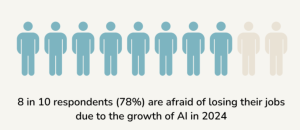This year has the potential to be a shocker when it comes to layoffs.
According to data from ResumeBuilder, 2024 really could be the year where headcount reductions really do accelerate. Some 38% of businesses it surveyed said layoffs were likely in their company this year, while according to HR leader Robert Barber, nine in ten employers expect more layoffs this year, and AI continues to give people worries about job losses:


Source: Myperfectresume
But reducing headcount is not something that employers can do lightly and without due regard to the law.
For companies that fail to adhere to separation laws may face extreme financial and reputational risk—both of which can result in long-lasting consequences. Most HR professionals know that workforce reductions are never easy, but they’re particularly painful if they lead to litigation.
So what do employers need to know?
Broadly, they need to make sure they have thoroughly familiarized themselves with the federal WARN Act, as well as some state-specific counterparts.
Here is the low-down on what you need to know:
WARN Act: The basics:
First, it’s important to understand the basics of the Worker Adjustment and Retraining Notification Act of 1988 (the WARN Act).
This federal law was first created to protect employees, their families, and communities by requiring employers to provide advance notification of significant business changes like plant closings and layoffs.
The 60-day notice requirement offers employees and their families adequate transition time and enables communities to brace for the potential impact on local businesses.
The WARN Act requires most employers with 100 or more employees to provide notification 60 calendar days before a planned closing or mass layoff.
Specifically, the WARN Act goes into effect when 50 or more employees are laid off at a single site of employment. There are a few exceptions, like unforeseeable business circumstances, faltering companies, and natural disasters.
When a workforce reduction is sizable enough to trigger the WARN Act, employees should be given at least 60 days’ notice of the upcoming changes. If proper notice isn’t given, affected employees are entitled to an amount equal to back pay and benefits for the 60-day notice period.
Though the Department of Labor oversees the WARN Act, violations must be handled by private legal action, such as individual or class-action lawsuits.
It sounds simple – but it seldom is
Sounds simple enough, right?
Not exactly.
In addition to the federal WARN Act, some states have imposed even stricter separation requirements, commonly referred to as mini-WARN Acts.
In New York State, for example, the NYS WARN Act applies to private employers who employ at least 50 full-time employees within the state, creating a lower threshold than the federal WARN Act’s minimum of 100 full-time employees.
Additionally, the notice period is 90 days versus the 60-day federal requirement.
A June 2023 amendment to the NYS WARN Act clarified that individuals who work remotely but are “based” at an employment site count toward the threshold when evaluating for WARN application.
Further, a November 2023 amendment to the New York Labor Law requires employers in New York to provide eligible employees with notice of their right to file for unemployment insurance upon permanent or indefinite separation from employment, a reduction in hours, temporary separation, or another qualifying interruption of employment that results in total or partial unemployment.
And those are just some of the requirements for New York.
New Jersey’s WARN Act provides employees with even greater protection, including mandatory severance pay.
The NJ WARN Act requires a 90-day notice period for employers with at least 100 employees nationwide, regardless of full- or part-time status, years of employment, or hours worked per week.
Employers must also pay terminated employees one week of severance for each year of service at the company. If employers fail to meet the 90-day notice period, they are required to pay an additional four weeks of severance pay to each terminated employee.
HR professionals have a lot to juggle
As evidenced by this small sample of separation-related laws, HR professionals have a lot to juggle when conducting layoffs.
And we haven’t even touched on other basics including the employee offboarding experience, the need to evaluate for discrimination, and generating and delivering necessary waivers.
The price of non-compliance
So what happens if you don’t adhere to separation laws?
Well, it depends!
In August 2023 a class-action suit was filed against Yellow Corporation and its subsidiaries, alleging violation of the WARN Act, where the company failed to provide the required 60-day layoff notice to its 30,000 employees.
Since employees were located in multiple states, the suit seeks wages and benefits for each state’s required notification period (60 days versus 90). Yellow Corporation ultimately filed for Chapter 11 bankruptcy, meaning the potential repercussions will be limited.
On the other hand, Twitter, now known as X Corp., is the defendant in a long list of alleged WARN Act violations, the most recent filing of which was in April 2023.
When Elon Musk purchased the company in October 2022, he promptly laid off more than half the company’s workforce. Though some employees received the required notice, others in the class-action suit allege violation of the federal and California WARN Acts.
What is clear, is that when it comes to WARN Act violations, the dollar amount is painful enough. But it’s much harder to measure the long-lasting impact negative press has on the company brand, like its ability to hire and retain top talent.
As more states implement mini-WARN Acts and stricter separation laws, HR professionals have more compliance responsibilities than ever before – a daunting task given the always-changing employee landscape.
So, familiarize yourself with the law before the need arises.
In any case, the more you know, the better off you’ll be.
